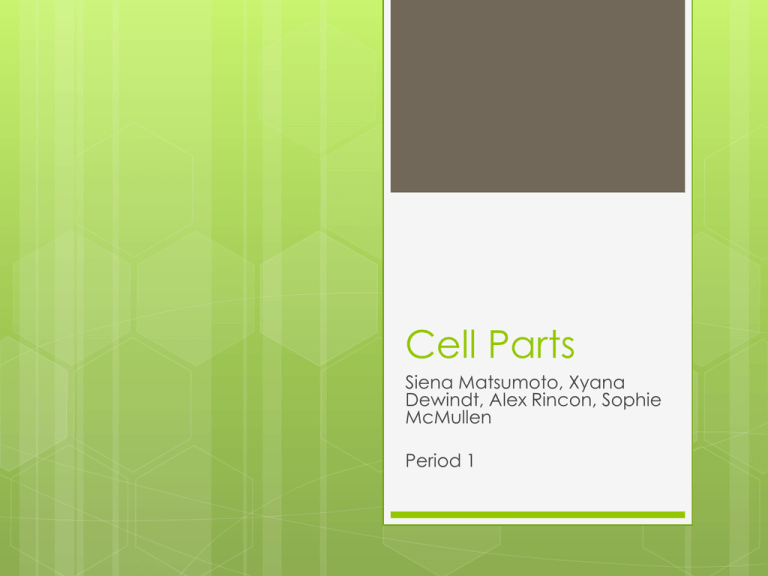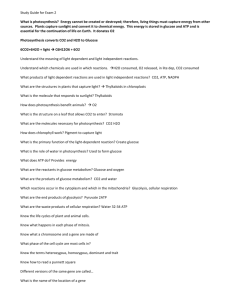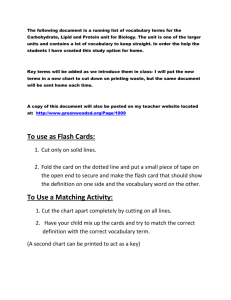Cell Parts
advertisement

Cell Parts Siena Matsumoto, Xyana Dewindt, Alex Rincon, Sophie McMullen Period 1 Vocab ATP: It is one of the principle chemical compounds that cells use to store and release energy. Photosynthesis: The process when plants use energy from sunlight to convert water and carbon dioxide into high energy carbohydrates and oxygen. Pigments: Plants gather the sunlight with these light absorbing molecules. Vocab Continued Calorie: used on food labels calorie: the amount of energy needed to raise the temperature of one gram of water 1 degree Celcius glycolysis: the process in which one molecule of glucose is broken in half, producing two molecules of pyruvic acid, a 3-carbon compound Aerobic: activity that requires oxygen (photosynthesis) Anaerobic: activity that doesn’t require oxygen (Calvin Cycle) Cell Photosynthesis Photosynthesis Takes place in chloroplast Chemical Equation Reactants-> Products Light Dependent Reaction Part 1 of Photosynthesis Light Independent Reaction (Calvin Cycle) Part 2 of Photosynthesis: -Glucose is the product Cellular Respiration Anaerobic (1) Glycolysis -sugar is broken down -takes place in the cytoplasm Input: glucose Output: 2 Pyruvates, net gain of 2 ATP B. Fermentation Input: Pyruvates Output: ethyl alcohol or lactic acid, CO2, NAD+ A. Aerobic (2) Krebs Cycle -takes place in the matrix of the mitochondria Input: 2 Pyruvates Output: 4 CO2, 2 ATP, some NADH&FADH2 B. Electron Transport System -occurs on the cristae of mitochondria -as electrons move energy is given off -produces the most ATP Input: 6O2 Output: 6H2O A. 36 ATP produce in all Glycolysis Cytoplasm Without Oxygen Fermentation Cytoplasm With Oxygen Krebs Cycle Mitochondria Matrix Electron Transport System Mitochondria Cristae Photosynthesis Cellular Respiration Where? Chloroplast Mitochondria When? Presence of Light All the Time Input? CO2 and H2O Glucose and O2 Output? Glucose and O2 CO2 and H2O Energy Source? Light Chemical Bonds Energy Result? Energy Stored Energy released Animal or Plant? Plants Only Both Multiple Choice 1. a. b. c. d. Where does Photosynthesis occur? Plants and Animals Plants Ribosomes Nucleus … 2. What is the total number of ATPs produced in Cellular respiration? a. b. c. d. 4 2 36 32 … 3. When is cellullar respiration present? a. b. c. d. All the time In the presence of light In the presence of water Without light … 4. What is the chemical equation for Photosynthesis? a. b. c. d. 6O2+C6H12O6---sunlight->H2O+6CO2 6H2O+6CO2—sunlight->6O2+C6H12O6 CO2+C12C6O12-> H2O Products->Reactants … 5. What role do pigments play in Photosynthesis? a. b. c. d. Give plants green coloring Absorbs water Hold protein Absorbs energy from sunlight … 6. How do cells use ATP? a. b. c. d. Used as a protein Used as a protection for the cell Used to store and release energy Used to transfer electrons … 7. What is the product of the Calvin Cycle? a. b. c. d. H2O 2 ATP Glucose CO2 … 8. What is a granum made up of? a. b. c. d. Pigments stacks of thylakoids Stacks of stromas Inner membrane … 9. What is the input of Glycolysis? a. b. c. d. Oxygen Water pyruvates glucose … 10. Which correctly states the output of the Krebs Cycle? a. b. c. d. Ethyl alcohol Lactic acid CO2 and NADH+ 4CO2, 2 ATP, some NADH and FADH2 Answer Key 1. 2. 3. 4. 5. 6. 7. 8. 9. 10. B C A B D C C B D D







